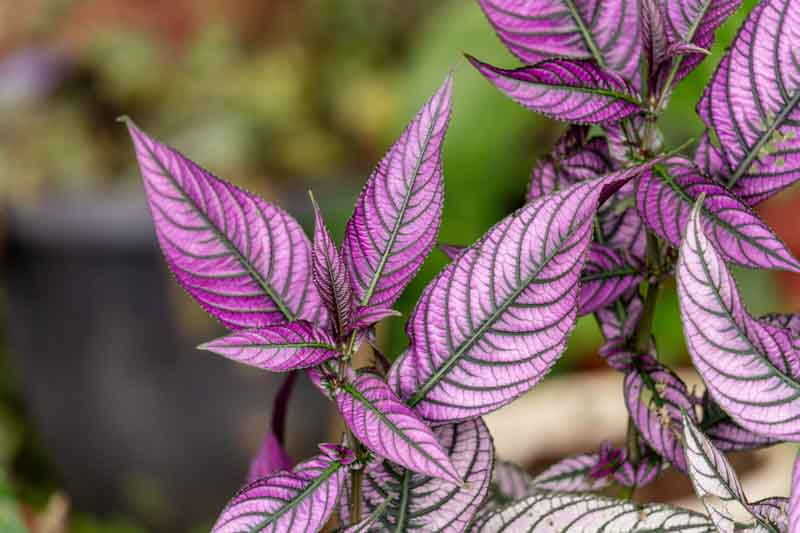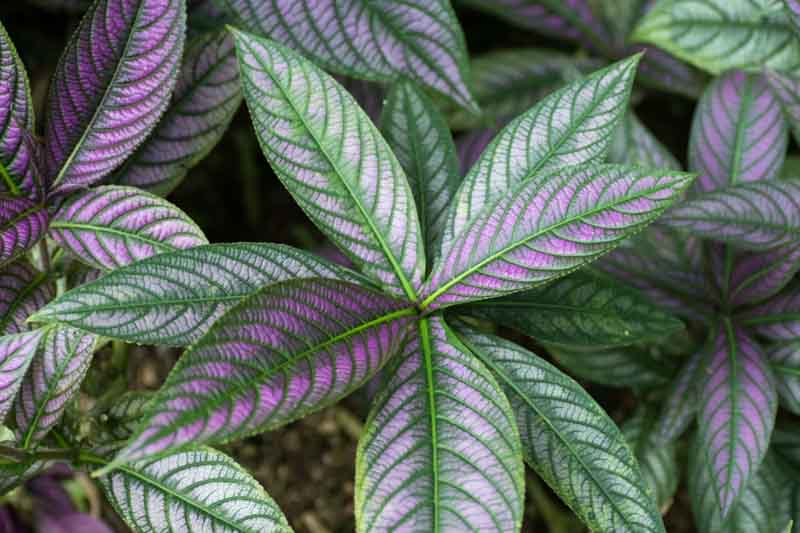Persian Shield, Royal Purple Plant, Strobilanthes dyerianus
Strobilanthes dyeriana, or Persian Shield, stands out in the plant world for its dazzling foliage, offering a touch of the tropics to gardens and homes alike. Its care requirements are manageable for gardeners of all levels, providing a rewarding experience for those looking to add vibrant color and texture to their plant collection.
Persian Shield is a foliage plant celebrated for its vibrant, iridescent leaves that exhibit shades of purple, silver, and green. Its unique coloration and texture make it a standout in any garden setting.
Native: This plant is native to Myanmar (Burma), where it thrives in the warm and humid conditions of its tropical climate. Persian Shield belongs to the acanthus family (Acanthaceae), along with the Polka Dot Plant or Bear’s Breeches.
Plant Type and Habit: It is a tropical, evergreen shrub or sub-shrub, grown as an annual in cooler climates, with a bushy habit, prized for its striking foliage rather than its flowers.
Size: Typically, it grows to about 3-4 feet (90-120 cm) in frost-free climates, but only 1-3 feet (30-90 cm) in height and spread in cooler climates, making it a suitable choice for both garden beds and containers.
Flowers: The Persian Shield produces small, tubular, lavender to pale blue flowers in short terminal spikes, which are often overlooked in favor of its stunning leaves. Flowers appear in late fall to early winter, depending on the climate.
Foliage: Its leaves, 8 inches long (20 cm), are the main attraction, lance-shaped, pointed, and quilted in texture, dark green leaves with a striking metallic sheen over a reddish-purple flush.
Hardiness: It is hardy in USDA zones 10-11; in cooler climates, it can be grown as an annual or brought indoors during winter.
Award: Recipient of the prestigious Award of Garden Merit of the Royal Horticultural Society.
Uses: It’s primarily used as an ornamental plant, perfect for adding color to shaded garden areas, containers, and indoor settings.
Toxicity: There are no significant reports of toxicity to humans or pets, making it safe for most garden settings.
Deer and Rabbits: Its foliage is generally resistant to deer and rabbits, likely due to its slightly tough texture and intense coloration.
Invasiveness: It is not considered invasive in most regions, though it can spread through self-seeding where conditions are ideal.

Growing and caring for Persian Shield involves meeting its basic needs for light, water, soil, and temperature to enjoy its vibrant, iridescent foliage.
Light: Persian Shield thrives in partial shade but can tolerate morning sun. Too much direct sunlight can fade its vibrant colors, while too little light can reduce the intensity of its leaf coloration.
Soil: This plant prefers well-draining, rich soil high in organic matter soil. Amend garden soil with compost or a well-balanced potting mix if planting in containers.
Water: Keep the soil consistently moist but not waterlogged. During hot, dry periods, water the plant regularly to prevent the soil from drying out completely. Reduce watering in the winter.
Temperature and Humidity: Persian Shield does best in warm, humid environments, similar to its native tropical habitat. It’s hardy in USDA zones 10-11. In cooler climates, it can be grown as an annual or brought indoors during the winter months. If grown indoors, maintain high humidity by placing the pot on a tray of wet pebbles or using a humidifier.
Fertilization: Feed the plant with a balanced, water-soluble fertilizer every four weeks during the growing season to support its vigorous growth and vibrant foliage.
Pruning: Prune in early spring to encourage bushier growth and maintain the desired shape. Pinching back the stem tips can also promote a fuller plant.
Repotting: Repot Persian Shield annually in spring to encourage healthy growth. Choose a pot one size larger with adequate drainage holes. Use a well-draining, fertile potting mix. Gently loosen the roots, transplant, and water thoroughly. This refreshes the soil, prevents root crowding, and supports the vibrant growth of this stunning plant.
Propagation: Typically propagated from cuttings, this plant can also grow from seed. Early spring or summer basal or softwood cuttings root easily in water or moist medium. Late summer or fall cuttings are ideal for overwintering indoors, ensuring year-round growth and preservation of the plant’s unique characteristics.
Overwintering: In regions outside its hardiness zones, bring the plant indoors before the first frost. Place it in a bright, indirect light source and reduce watering.

Persian Shield may encounter some pests and diseases, along with common problems.
Spider Mites: Indicated by fine webbing on the plant and tiny, moving dots (the mites), these pests thrive in dry conditions. Increase humidity and wash the plant with water or use miticides if necessary.
Mealybugs: These pests appear as small, white, cottony masses on leaves and stems, sucking sap and weakening the plant. Treat by dabbing with alcohol or applying insecticidal soap.
Aphids: These small insects suck sap from leaves, leading to distorted growth. Wash them off with water or treat with insecticidal soap.
Root rot: Overwatering or poorly draining soil can lead to fungal infections at the root level, causing the plant to wilt and potentially die. Ensure proper drainage and let the soil dry slightly between waterings.
Powdery mildew: A fungal disease that appears as a white powdery coating on leaves. Improve air circulation and treat with fungicides if necessary.
Leaf Fading: Direct sunlight can bleach the vibrant colors of Persian Shield. Provide filtered light or partial shade.
Legginess: Insufficient light may cause the plant to stretch. Prune back leggy growth and provide more light.
Dropping Leaves: Extreme temperature changes, drafts, or sudden changes in watering habits can cause leaf drop. Keep the plant in a stable environment and follow consistent watering practices.

Strobilanthes, including Persian Shield, are perennials in their native tropical climate and USDA zones 9-11. In cooler zones, they are often grown as annuals unless brought indoors or protected during winter. With proper care, they can come back either by regrowth or reseeding.
Persian Shield prefers partial shade but can tolerate morning sun or dappled sunlight. In full sun, especially in hot climates, its leaves may scorch or fade, losing their vibrant color. It thrives best in environments that mimic the filtered light of its native habitat.
Common reasons include overwatering leading to root rot, under-watering, too much direct sunlight, or insufficient humidity. Pests and diseases can also stress the plant. Check the soil moisture, light conditions, and for signs of pests or diseases to address the issue.
Persian Shield can tolerate temperatures down to about 50°F (10°C). It is sensitive to cold and should be protected from frost. In regions experiencing colder temperatures, it’s best to grow Persian Shield as a container plant that can be moved indoors during winter.
The best place to plant Persian Shield is in partial shade where it receives indirect sunlight or morning sun. It thrives in well-draining, fertile soil with consistent moisture. Ideal locations include under the canopy of larger trees, on the east side of buildings, or in mixed container arrangements.
Persian Shield cannot survive frost; it is sensitive to cold temperatures and frost damage. To protect it in cooler climates, bring container-grown plants indoors or provide mulch and frost protection for plants in the ground. In areas with mild winters, it may survive outdoors with adequate protection.
| Hardiness |
10 - 11 |
|---|---|
| Heat Zones |
1 - 12 |
| Climate Zones | 23, 24, H1, H2 |
| Plant Type | Shrubs |
| Plant Family | Acanthaceae |
| Exposure | Full Sun, Partial Sun |
| Season of Interest |
Spring (Early, Mid, Late) Summer (Early, Mid, Late) Fall Winter |
| Height |
1' - 4' (30cm - 120cm) |
| Spread |
1' - 4' (30cm - 120cm) |
| Spacing |
12" - 48" (30cm - 120cm) |
| Maintenance | Low |
| Water Needs | Average |
| Soil Type | Loam, Sand |
| Soil pH | Acid, Neutral, Alkaline |
| Soil Drainage | Moist but Well-Drained |
| Characteristics | Showy, Evergreen |
| Garden Uses | Beds And Borders, Patio And Containers, Wall-Side Borders |
| Garden Styles | Mediterranean Garden |
| Hardiness |
10 - 11 |
|---|---|
| Heat Zones |
1 - 12 |
| Climate Zones | 23, 24, H1, H2 |
| Plant Type | Shrubs |
| Plant Family | Acanthaceae |
| Exposure | Full Sun, Partial Sun |
| Season of Interest |
Spring (Early, Mid, Late) Summer (Early, Mid, Late) Fall Winter |
| Height |
1' - 4' (30cm - 120cm) |
| Spread |
1' - 4' (30cm - 120cm) |
| Spacing |
12" - 48" (30cm - 120cm) |
| Maintenance | Low |
| Water Needs | Average |
| Soil Type | Loam, Sand |
| Soil pH | Acid, Neutral, Alkaline |
| Soil Drainage | Moist but Well-Drained |
| Characteristics | Showy, Evergreen |
| Garden Uses | Beds And Borders, Patio And Containers, Wall-Side Borders |
| Garden Styles | Mediterranean Garden |
How many Strobilanthes dyeriana (Persian Shield) do I need for my garden?
| Plant | Quantity | |
|---|---|---|
| Strobilanthes dyeriana (Persian Shield) | N/A | Buy Plants |
Create a membership account to save your garden designs and to view them on any device.
Becoming a contributing member of Gardenia is easy and can be done in just a few minutes. If you provide us with your name, email address and the payment of a modest $25 annual membership fee, you will become a full member, enabling you to design and save up to 25 of your garden design ideas.
Join now and start creating your dream garden!
Create a membership account to save your garden designs and to view them on any device.
Becoming a contributing member of Gardenia is easy and can be done in just a few minutes. If you provide us with your name, email address and the payment of a modest $25 annual membership fee, you will become a full member, enabling you to design and save up to 25 of your garden design ideas.
Join now and start creating your dream garden!